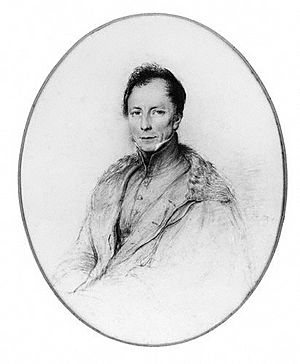Henry Kater facts for kids
Quick facts for kids
Henry Kater
|
|
|---|---|
 |
|
| Born | 16 April 1777 Bristol, Great Britain
|
| Died | 26 April 1835 (aged 58) |
| Nationality | English |
| Awards | Copley Medal (1817) Gold Medal of the Royal Astronomical Society (1831) |
| Scientific career | |
| Fields | Physics |
Henry Kater was a clever British physicist and inventor. He was born in Bristol, England, on April 16, 1777. He became famous for his work in physics and for creating special tools. These tools helped scientists measure things like gravity and improve how we look at the stars.
Contents
Early Life and Career
Henry Kater was born in Bristol. At first, he planned to study law. But when his father passed away in 1794, he changed his mind.
Joining the Army
Instead of law, Henry joined the army. He became an officer in the 12th Regiment of Foot. His army unit was sent to India.
Work in India
In India, Henry helped with a big project. It was called the Great Trigonometric Survey. This survey helped map out large parts of India. It was a very important job for understanding the land.
Return to England
After some time, Henry's health was not good. He had to return to England. In 1808, he went to the Royal Military College in High Wycombe. He studied there as a lieutenant. Soon after, he became a captain. In 1814, he left the army. He then spent the rest of his life doing scientific research.
Amazing Scientific Discoveries
Henry Kater made many important contributions to science. He was especially interested in physics and measurements.
Telescope Improvements
One of his first big projects was comparing telescopes. He looked at two types: the Cassegrainian and Gregorian telescopes. He found that the Gregorian design was not as good. His work helped improve how telescopes were made.
Kater's Pendulum
His most famous invention was Kater's pendulum. This special pendulum helped scientists measure the strength of gravity. He first used it in London. Then, it was used in many other places across the country. This invention was a huge step forward for physics.
Floating Collimator
Henry also invented the floating collimator. This tool was very helpful for astronomy. It made it easier to make accurate observations of stars and planets.
Measuring Standards
He also worked on making sure measurements were correct. He studied the official standards for length and weight in Britain. In 1832, he even helped Russia check their measurement standards. For his help, Russia gave him an award in 1814.
Awards and Recognition
Henry Kater received many honors for his work.
- In 1817, he won the Copley Medal. This is a very important science award.
- In 1831, he won the Gold Medal of the Royal Astronomical Society. This award is for great work in astronomy.
- He was also chosen to be a member of important science groups. These included the Royal Society and the Royal Swedish Academy of Sciences. In 1832, he became a member of the American Academy of Arts and Sciences.
Prismatic Compass
Henry Kater is also known for inventing the prismatic compass. This type of compass helps people find directions more accurately. Another person later patented it, but Kater was the inventor.
Other Studies
He also studied compass needles. He did many experiments to understand how they work. He even wrote part of a book about "Mechanics." Henry was also interested in space. He wrote papers about observing Saturn's rings. He also found a way to figure out longitude using lunar eclipses.

